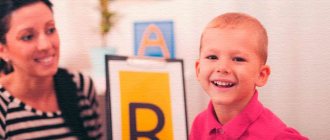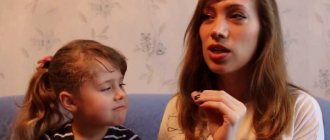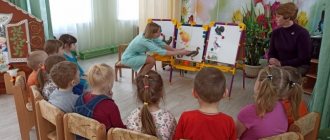Sh pronunciation is normal
This sound is the basic one in the hissing group. Having mastered its articulation, the child will easily learn to correctly pronounce other sounds from this group. The lips take a “horn” position: they are pushed forward a little so that a “window” shape is obtained. When pronouncing a sound, the teeth must be closed.
The tongue should be in a “cup” position: the tip is behind the upper teeth, and its sides are pressed tightly against the teeth. This allows you to direct the exhaled stream in the middle. If everything is done correctly, it will turn out wide and warm. The vocal cords are open, so Ш is a voiceless consonant.
Types and mechanisms of violations
Incorrect pronunciation of a hissing group is called sigmatism, and their replacement with other sounds is called parasigmatism. Sh may be absent from a child’s speech, but he will not replace it with other phonemes. There are several types of hissing sigmatism, differing in the mechanism of occurrence:
- Interdental – speech with such distortion is called a lisp. With this sigmatism, the tongue does not take the desired “cup” position, but passes between the teeth. The cause may be a short hyoid frenulum; high and narrow sky.
- Lateral - in speech, instead of Ш, a sound is produced that has a “squelching” sound. During pronunciation, one corner of the lips rises higher than the other; the lower jaw is also shifted to one side; the “cup” shape does not work out because the back of the tongue forms a connection with the dental alveoli on only one side. The reason for the appearance of such distortion may be weak tone of the articulatory muscles and incorrect bite.
- Nasal - instead of Ш, the child pronounces X with a nasal connotation. The tongue is in a lower position, and the back is raised up. It is because of the high tension on the back of the tongue that this sigmatism appears.
Depending on the type of hissing sigmatism, the speech therapist will select the method of sound production.
Speech therapy diagnostics
The speech therapist evaluates the development of all components of speech to determine a speech defect. In case of distorted pronunciation of sounds during diagnosis, he pays special attention to:
- appearance of the lips, state of the bite, muscle tone of the tongue;
- articulatory and facial motor skills;
- duration and force of exhalation;
- pronunciation of sound in isolation, in syllables, words, phrases and coherent speech;
- whether the child distinguishes it from other phonemes.
When assessing the anatomy of the articulatory apparatus, the specialist looks at the bite, palate, appearance of the tongue (too narrow or clumsy wide), and the hyoid frenulum. If there are any deviations that may be the cause of the distortion, the speech therapist can refer you to other specialists (surgeon, orthodontist).
When checking the work of facial muscles, the speech therapist asks the child to depict emotions (joy, sadness, surprise, etc.); checks how the facial muscles work individually (asks you to raise your eyebrows, smile, etc.); In addition to motor skills, the child is shown images of various emotions and must choose the appropriate mood for each picture.
During the diagnosis of articulatory motor skills, the speech therapist gives tasks for statics (retention) and dynamics:
- Smile, stretch out your lips in a “tube” or take a position as when pronouncing O. You need to fix them in a certain position for a few seconds.
- Move your jaw in different directions.
- Relax your tongue, make it wide, place and hold it on your lower lip, or make it narrow, extending it as far as possible.
- Perform the “cup” exercise.
- Raise - lower the tongue.
- Move them in different directions.
- Draw a horse.
All exercises are performed by demonstration, that is, the adult shows first, and the child then repeats. The speech therapist notes from what time the child was able to complete the task correctly or when he failed; draws attention to the state of muscle tone of the articulatory apparatus.
To check the strength and duration of exhalation, it is suggested to perform the following tasks:
- blow off a light object (feather, piece of cotton wool);
- play the game “Who will kick the ball further” - the child competes with an adult who will blow out the object further;
- play the pipe.
Before performing tasks, the speech therapist explains how to breathe correctly. During diagnosis, he also pays attention to the formation of speech breathing.
When examining the sound-pronunciation aspect of speech, the speech therapist examines all groups of sounds. When a child pronounces a sound, the speech therapist pays attention to the position of the articulation organs. At first, the phoneme is pronounced separately from the others. Then in various syllables (SHA, OSH, USHU, ShPA, etc.); in words, and the sound must be at the beginning, middle or end (HAT, MOUSE, RESED, etc.).
Then the speech material is complicated, and the child repeats phrases and sentences after the adult (BIG EARS, DASHIN'S FUR COAT, WIDE SCARF, etc.). To check the pronunciation of Ш in independent coherent speech, use the following tasks:
- make up a phrase/sentence from the given words;
- who can name more objects that have Sh in their names;
- tell what is drawn in the plot picture.
Speech and visual material should be selected taking into account the child’s age. When checking the pronunciation of a particular sound, you do not need to use words containing mixed groups and oppositional phonemes.
The speech therapist also checks the state of phonemic hearing and the skill of sound-letter analysis. For this purpose, special tasks are selected:
- do some action after hearing a given sound (it is pronounced separately, in combination with other phonemes);
- Determine the position of a sound in a word.
Based on the results of the examination, the speech therapist draws up a plan of correctional work and selects appropriate methods of sound production.
Summary of individual speech therapy sessions. Automation of sound Ш
Summary of an individual speech therapy lesson on sound automation [Ш] for a child 5-6 years old
Author: Ponomareva Tatyana Aleksandrovna, teacher-speech therapist of the Municipal Preschool Educational Institution "Kindergarten No. 166 "Swallow", Saratov
Synopsis of an individual speech therapy lesson on sound automation [Ш] "Road" for Masha"
Description of the material: I offer you a summary of a lesson on sound automation [Ш] for children of senior preschool age (5-6 years old). This material will be useful to kindergarten speech therapists. This summary is for the stage of sound automation in syllables, words, sentences and poems. Form of delivery: individual lesson. Equipment: Masha doll, box, object pictures with sound [Ш], pictures with tasks, illustrations for poems. Goal: automation of sound [Ш] Objectives: a) correctional: to develop clear and differentiated movements of the articulatory apparatus; learn to pronounce the sound [Ш] in isolation, in syllables, words, sentences, poems; clarify the acoustic and pronunciation image of the sound [Ш], b) developmental: develop phonemic processes, memory, attention, motor skills; improve lexical and grammatical categories; c) educational: to cultivate a desire to help a friend, a desire to speak beautifully and correctly, and to create positive motivation in class. Progress of the lesson: I. Organizational moment. — On the way here I met the doll Masha. She forgot the way home. Let's take her home to her mom? Okay, I just know which path we need to take. And to make it more fun, we will perform different tasks along the way. II. Main part. 1. Articulation gymnastics. - Let's teach Masha to do the following exercises: “Fence/Tube” - 5 times. “Delicious jam” - 5 times. “Swing” - 10 times. “Cup” - 10 seconds. “Mushroom” - 5 seconds. “Horse” - 5 times. 2. Repetition of articulation of sound [Ш]
- Look, it’s crawling along the path and hissing! Let's hiss just like him. Now move your finger along the path and hiss. Now move your pencil and don’t forget to hiss like a snake. — Tell Masha how we pronounce the sound [Ш]. What do our tongue, lips, teeth do when pronouncing the sound [Ш]? (lips are rounded, teeth are closed with a small gap, the tongue looks like a “cup” and is raised by the tubercles behind the upper teeth). 3. Automation of sound in syllables. - Look, there are footprints on this path. Let's read what it says there. Shi-shu-sho Sha-she-shu Shu-sho-sha Shto-shty-shta Shto-shtu-shta Shko-shtu-shku Shko-shko-shku Shwe-shva-schvu Shwe-shty-shta 4. Finger gymnastics. “Little Frog” I will connect the ring finger, the middle one, with the big one. I’ll bend the other two back and show Little Frog. 5. Automation of sound in words. a) “Name the word and determine the place of the sound.”
- What is this box on the path?
Look what's in it. - Name the words and arrange the pictures accordingly: with the sound [Ш] at the beginning of the word, in the middle and at the end of the word. (Subject pictures: fur coat, chamomile, scarf, shirt, shower, wardrobe, cat, mouse, reeds, chess). b) “Count.”
-Who is that sleeping in the clearing? (Cat). Who does a cat see in her dream? (Mice). Count how many mice the cat saw in her dream. (One mouse, two mice, three mice...)
6. Automation of sound in sentences. - Match the action words with suitable pictures. Make up and speak sentences. Let's find out what Masha did. (Masha ate a chocolate bar. Masha ate a pear. Masha ate a cherry. Masha washed a pear. Masha saw a school. Masha went up to the school. Masha was embroidering a pillow. Masha bought a chocolate bar. Masha was hemming her shorts. Masha was ironing her shorts.)
7. Automation of sound in poems.
The cockerel found the bag. And there was a pot in the bag. And in the pot there are peas and a few crumbs.
Reeds rustled in the darkness. The cat thought it was a mouse. She ran into the reeds - There is not a soul in the reeds. III. Summarizing. “But I can see whose house is hidden behind the reeds.” Here we are. Masha says thank you. You took her home and taught her to pronounce the sound [Ш]. How do we pronounce the sound [Ш]? Remember who we met along the way? Well done! Today you tried and pronounced the sound correctly and helped the doll Masha find her way home.
We recommend watching:
Summary of educational activities in a compensatory preparatory group for children with severe speech impairments. Summary of individual lessons in a secondary speech therapy group on the topic “Automation of sound C.” Summary of educational activities in a senior compensatory group for children with severe speech impairments. 3 Summary of individual speech therapy sessions. Automation of sound L
Similar articles:
Lesson notes for a senior speech therapy group. Sound K
Summary of a speech therapy session with primary school children diagnosed with ODD
Summary of GCD for children of the senior speech therapy group
Summary of a speech therapy session with children 5-6 years old with mental retardation
Summary of educational activities in the older group of children with severe speech impairments on the topic: “Sounds S - Z”
Articulation and breathing exercises
Before moving on to sound production, the desired articulatory pattern is formed and the strength and duration of exhalation is trained. To pronounce sibilants correctly, the child is taught to make his tongue wide and raise it. The main exercise in the complex is “Cup”. It is this position that forms the basis for the correct articulation of sibilants.
You can begin to perform it once you have developed the ability to make and keep your tongue wide.
First, the classes develop the ability to relax the tongue. To do this, perform patting movements with your lips or lightly bite them with your teeth - these are options for self-massage. They also train in holding the tongue in this position for some time. If difficulties arise with lifting it, select exercises to practice the upper position (“Horse”, “Mushroom”, “Brush your upper teeth” and other similar tasks).
After the child succeeds in all of the above, they begin to perform the “Cup” exercise. The child raises the tip and lateral edges of the tongue and holds them in this position. To increase the effect, you can pour a little water into the “Cup” so that the baby tries to hold it.
Other exercises are also recommended:
- To complete this task you will need cotton wool. A wide tongue is placed on the lower lip. The child says an elongated F and tries to blow off the cotton wool as far as possible.
- The wide tip of the tongue is placed on the upper lip, and the side edges should be pressed tightly. A piece of cotton wool or a feather is placed on the tip of the nose. The child tries to blow it off by holding his tongue in the upper position. He will be able to do this if the air stream passes through the middle.
The listed tasks are aimed not only at developing a long exhalation, but also develop the ability to relax the tongue, make it wide, and in this state lift and hold it behind the teeth. When the speech therapist sees that the child can maintain the necessary articulatory postures, he begins to set the Sh. If the movements are not sufficiently formed and the muscles of the tongue are not strengthened, then the child will not be able to fix the correct position, and the sound will be pronounced only with mechanical assistance. Therefore, the preparatory stage is mandatory in correctional work.
The described exercises for sibilants are also used to correct the pronunciation of a sonorant group of sounds, because when they are pronounced, the tongue also takes an upper position.
Setting the sound sh
The production of the “sh” sound, namely the correction of the “sh” sound profile, depends on the reasons for which this occurs. Sometimes the correct articulation of the sound Ш occurs after a visit to the orthodontist, who, with the help of orthodontic structures, expands the upper palate and corrects the bite. If the teeth are normal or pronunciation does not improve after the dentist’s intervention, speech therapy exercises are needed. They are based on the development of the correct articulatory structure of the sound “sh”.
Correct articulation
To make the sound Ш, it is important to understand how the tongue should be placed:
- it should be wide with a raised leading edge towards the top;
- a gap should form between the tongue and palate at the upper incisors;
- at the same time, the lateral edges are in close contact with the molars of the upper jaw.
An important condition is the absolute symmetry of the language. The position of the lips is also important: they should be folded into a funnel.
Articulation gymnastics
An individual speech therapy session begins with articulation gymnastics for the sound “sh”. Articulation exercises delight children. We make the sound sh while playing:
- “Hippopotamus”: open your mouth wide, count to five, then close it.
- “Frog”: stretch your mouth into a smile without changing the position of your teeth.
- “Tube”: stretch your lips with a tube, hold them.
- “Pancake”: place a wide, relaxed tongue on the lower lip.
- “Jam”: lick your upper lip with a wide, cup-shaped tongue.
- “Brush”: move your tongue across the roof of your mouth, from your teeth to your throat.
Breathing exercises
After a set of articulation exercises, the child is asked to perform breathing exercises in a playful way:
- “Air football”: put a cotton ball on the table and offer to score a goal with an air stream from your mouth. To do this, the lips are folded into a tube, and the cheeks are not involved. Before teaching your child this exercise, you need to hold his cheeks with your fingers so that he does it with one even exhalation.
- “A butterfly sat on a flower”: cut out flowers and butterflies from colored cardboard and connect them with thread. Blow butterflies off flowers with a stream of air.
Setting option when there is no sound
If a child does not have Sh in his speech, and he does not use other phonemes instead, then the main emphasis is on articulatory gymnastics, namely the formation of a wide tongue rise. When the “Cup” exercise is performed correctly, the speech therapist begins to produce sound.
He asks the child to make a “Cup” and hide his tongue behind his teeth. Next, the speech therapist explains that you need to blow on your tongue and then you will get Sh. If the child pronounces X, then a clear hissing sound will not be produced. For convenience, they suggest pronouncing C, only the tongue is behind the upper teeth. To develop the correct pronunciation, you need to repeat it many times. To increase the effectiveness of classes, the speech therapist uses didactic games.
Setting Sh with distorted pronunciation
The method of presentation depends on the type of sigmatism. Each of them has its own reasons, so the speech therapist selects techniques to correct them:
- With the interdental variant, exactly the same preparatory work is carried out as in the absence of a phoneme in speech. The emphasis is on raising the tongue, so they additionally practice clear pronunciation of T, from which the sound will be made. When pronouncing T, the child keeps his mouth open. You need to pronounce the sound slowly, adding aspiration. Gradually, the speech therapist teaches the child to lengthen the air stream and not touch the tubercles with the tongue.
- For lateral distortion, a mechanical method is used. Before insertion, the lateral edges of the tongue are strengthened; They teach you to raise and hold your tongue behind your teeth, and form a strong, long, directed exhalation. For placement, you can use a special speech therapy probe or a teaspoon (if you are doing correction at home). Using a probe or spoon, the front part of the tongue is lifted and removed behind the upper teeth, moving it closer to the tubercles. The child bites the spoon and pronounces S. Gradually, the duration of exhalation increases, and the ability to lift and hold the tongue in the desired position independently is formed.
- The method of setting from P - this method is rarely used, because to pronounce a sonorant group the tongue occupies a similar position as for sibilants. Therefore, few children can speak R correctly if they have problems with the pronunciation of sibilants. The child, keeping his mouth open, pronounces R silently. An adult, using the handle of a teaspoon, stops the vibration. The result is hissing. Gradually, the spoon is used less, the child learns to keep his teeth together and make a hissing sound without mechanical assistance.
- Method of setting from whistlers. The child pronounces an elongated S, the adult places a teaspoon or probe under the front edge of the tongue, lifts it and moves it deeper into the mouth until he hears Sh in speech. Gradually, the child learns to independently lift and cup his tongue.
If there are disturbances in the tone of the tongue muscles, a course of speech therapy massage is prescribed. It is performed using probes (for this you need to undergo special training) or fingers wearing sterile disposable gloves. But along with the massage you need to do articulation gymnastics. Then the preparation of the organs of articulation for the production of Ш will be more effective.
The sound Ш is the main one in its group. Therefore, having corrected its pronunciation, it is easy to add other sibilants. You just need to explain the difference in articulation so that the child does not mix them up in speech. You need to start producing other hissing sounds when you have passed the stage of automating the sound Ш in speech.
Frontal speech therapy lesson in the senior group on the topic “Sound and the letter Sh.” Abstract
Speech therapy session in the senior group.
Sound and letter Sh. Description: This lesson was conducted in a senior speech therapy group. When preparing the lesson, the emphasis was on the development of the phonetic-phonemic aspect of speech in children. This lesson will be useful for speech therapists and preschool teachers. Purpose: To introduce children of senior preschool age to the sound “SH”. Objectives: 1. Teach children to characterize the sound “Ш” according to acoustic and articulatory characteristics.
2. Develop general, fine and articulatory motor skills of children. 3. Develop phonemic processes. 4. Practice analyzing words and sentences. 5. Instill in children self-control over newly introduced sounds. Progress of the lesson
1. Organizational moment Guys, let's greet each other with a song.
Logorhythmic greeting “Hello palms”
2. Announcement of the topic of the lesson.
The speech therapist puts a picture of Snakes on the board.
Who is this?
How does a snake hiss? (sh-sh-sh)
Today we will get acquainted with this sound.
3. Acoustic-articulatory image of sound. Pronunciation of an isolated sound Ш with the connection of oral, tactile-vibrational and acoustic control. Observing the position of articulation in the mirror: the lips are extended forward, the wide tongue is raised to the alveoli and creates a barrier to the air stream that passes through the middle of the tongue, the vocal cords do not vibrate (the neck is silent). The sound Ш is a consonant, dull, always hard, denoted by a blue chip. 4. The connection between sound and letters. Examination of the letter Ш. The letter Ш is like a scallop. Comb the doll, my friend! We put three teeth in a row and connect them at the bottom. 5. Development of phonemic hearing. The speech therapist names correct and incorrect sounding words.
Children should clap their hands when they hear the correct word. Cap, slipper, hat, cap.
Balysh, kids, kavysh, tabysh. Maiba, Kaiba, Thaiba, puck. Takhmats, chess, bakhmats, khammatas. 6. Physical exercise. Performing movements according to the text of the poem.
All the guys stood up together and walked in place. They stretched on their toes and turned to each other. We sat down like springs, and then sat down quietly. 7. Consolidation of sound in syllables. Sound analysis of syllables АШ, ША. The speech therapist lays out diagrams of syllables on the board, and the children say which diagram fits which syllable. 8. Consolidating sounds in words. The speech therapist hangs pictures on the board whose names contain the sound Ш. Children must sort these pictures into 3 groups: the sound Ш at the beginning of the word, in the middle of the word and at the end of the word. After this, the words are divided into syllables. Then the speech therapist, together with the children, conducts a detailed sound analysis of the word “shawl” and lays out a graphic diagram. 9. Fixing sound in sentences. Working on a deformed phrase. Children are asked to make sentences from words. There is porridge on the table. The drivers have a leather cap. 10. Fixing sound in text. Isolating words with the sound Ш from the text. The little animal is jumping - Not a mouth, but a trap. The frog will get both a mosquito and a fly. 11. Summary of the lesson. What sound does a snake make? What sound is this? Name words with the sound Ш at the beginning, in the middle, at the end of the word.
We recommend watching:
Summary of an individual educational activity with a 5-6-year-old pupil for the correction of sound pronunciation. Notes of an educational activity in a senior speech therapy group. Notes of a lesson in a senior speech therapy group. Notes of an individual correctional and developmental speech therapy lesson. Senior group
Similar articles:
Summary of educational activities in the older group of children with severe speech impairments on the topic: “Sounds S - Z”
Summary of educational activities in the senior group of children with severe speech impairments on the topic: “Sounds S - Sh”
Summary of a subgroup GCD to eliminate disturbances in sound pronunciation in children of the older group with severe speech impairments
Summary of educational activities in the senior speech therapy group on the topic “Cossacks and their traditions”
Logorhythmic lesson for children of senior preschool age with special needs on the topic: “What types of transport are there?”
![Producing the sound [L] to a child in stages. Articulation gymnastics, speech therapy exercises, pronunciation lessons with pictures](https://doktorobrubov.ru/wp-content/uploads/postanovka-zvuka-l-rebenku-poetapno-artikulyacionnaya-gimnastika-logopedicheskie-uprazhneniya-uroki-330x140.jpg)






